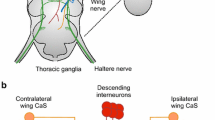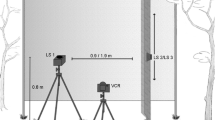Summary
The insect order Phasmida comprises species with a broad spectrum of wing morphism and flight ability. By monitoring the electrical activity of several pterothoracic muscles the motor output during tethered flight was recorded for several Phasmida, ranging from excellent fliers to non-winged species. Both winged and non-winged species can generate a motor pattern as judged by criteria used to identify the locust flight pattern. However, in non-fliers the probability of expressing this pattern, its duration and precision are reduced. The antagonistic activity of the chosen muscle pairs is clearly different from the motor output during leg movements, which argues for specific motoneuronal coordination released for different behavioural performances. The demonstration of flight motor output in all tested Phasmida indicates that neural structures including their functional connectivity can be maintained independently of the appropriate peripheral structures. With respect to evolution this supports the idea that central neuronal interactions can be more conservative compared to changes in the periphery.
Similar content being viewed by others
References
Arbas EA (1983) Neural correlates of flight loss in a Mexican grasshopper,Barytettix psolus. I. Motor and sensory cells. J Comp Neurol 216:369–380
Arbas EA, Tolbert LP (1986) Presynaptic terminals persist following degeneration of “flight” muscle during development of a flightless grasshopper. J Neurobiol 17:627–636
Bässler U (1983) Neural basis of elementary behavior in stick insects. Springer, Berlin Heidelberg New York
Bedford GO (1978) Biology and ecology of the Phasmatodea. Annu Rev Entomol 23:125–149
Beier M (1968) Phasmida (Staboder Gespenstheuschrecken). Handb Zool 4 (2) Sect. 10:1–56
Bentley DR, Kutsch W (1966) The neuromuscular mechanism of stridulation in crickets (Orthoptera: Gryllidae). J Exp Biol 45:151–164
Brunner von Wattenwil, Redtenbacher J (1908) Die Insektenfamilie der Phasmiden. Engelmann, Leipzig
Carlberg K (1986) Phasmida: a biological review (Insecta). Zool Anz 216:1–18
Clark JT (1974) A note onAcrophylla wülfingi Redtenbacher with a description of the male. Zool J Linn Soc 54:253–256
Delcomyn F (1987) Motor activity during searching and walking movements of the cockroach legs. J Exp Biol 133:111–120
Dumont JPC, Robertson RM (1986) Neuronal circuits, an evolutionary perspective. Science 233:849–853
Gewecke M, Kutsch W (1979) Development of flight behaviour in maturing adults ofLocusta migratoria: I. Flight performance and wing-stroke parameters. J Insect Physiol 25:249–253
Graham D, Wendler G (1981) The reflex behaviour and innervation of the tergo-coxal retractor muscle of the stick insectCarausius morosus. J Comp Physiol 143:81–91
Hennig W (1961) Die Stammesgeschichte der Insekten. Kramer, Frankfurt
Kukalová-Peck J (1978) Origin and evolution of insect wings and their relation to metamorphosis, as documented by the fossil record. J Morphol 156:53–126
Kukalová-Peck J (1986) New carboniferous Diplura, Monura, and Thysanura, the hexapod ground plan, and the role of thoracic side lobes in the origin of wings (Insecta). Can J Zool 65:2327–2345
Kutsch W (1971) The development of the flight pattern in the desert locust,Schistocerca gregaria. Z Vergl Physiol 74:156–168
Kutsch W (1974) The influence of wing sense organs on the flight motor pattern in maturing adult locusts. J Comp Physiol 88:413–424
Kutsch W (1985) Pre-imaginal flight motor pattern inLocusta. J Insect Physiol 31:581–586
Kutsch W (1989) Development of the flight motor pattern. In: Goldsworthy GJ, Wheeler CH (eds) Insect flight. CRC Press, Boca Raton, Fld, pp 51–73
Kutsch W, Stevenson P (1984) Manipulation of the endocrine system ofLocusta and the development of the flight motor pattern. J Comp Physiol A 155:129–138
Kutsch W, Stevenson PA (1988) Demonstration of adult-specific flight motor pattern in isolated ganglia and all instars ofLocusta. Symp Biol Hung 36:545–558
Marquardt F (1940) Beiträge zur Anatomie der Muskulatur und der peripheren Nerven vonCarausius (Dixippus) morosus Br. Zool Jb Anat 66:63–128
Möhl B (1989) Sense organs and the control of flight. In: Goldsworthy GJ, Wheeler CH (eds) Insect flight. CRC Press, Boca Raton, Fld, pp 75–97
Pearson KG, Wolf H (1987) Comparison of motor patterns in the intact and deafferented flight system of the locust. I. Electromyographic analysis. J Comp Physiol A 160:259–268
Pearson KG, Wolf H (1989) Timing of forewing elevator activity during flight in the locust. J Comp Physiol A 165:217–227
Pringle JWS (1981) The evolution of fibrillar muscle in insects. J Exp Biol 94:1–14
Provine RR (1983) Chicken muscular dystrophy: an inherited disorder of flight. Dev Psychobiol 16:23–27
Provine RR (1984) Wing-flapping during development and evolution. Am Sci 72:448–455
Provine RR, Strawbridge CL, Harrison BJ (1984) Comparative analysis of the development of wing-flapping and flight in the fowl. Dev Psychobiol 17:1–10
Ramirez JM, Pearson KG (1988) Generation of motor patterns for walking and flight in motoneurons supplying bifunctional muscles in the locust. J Neurobiol 19:257–282
Reye DN, Pearson KG (1988) Entrainment of the locust central flight oscillator by wing stretch receptor stimulation. J Comp Physiol A 162:77–89
Robertson RM (1985) Central neuronal interactions in the flight system of the locust. In: Gewecke M, Wendler G (eds) Insect locomotion. Parey, Berlin, pp 183–194
Robertson RM (1987) Interneurons in the flight system of the cricketTeleogryllus oceanicus. J Comp Physiol A 160:431–445
Robertson RM, Olberg RM (1988) A comparison of the activity of flight interneurones in locusts, crickets, dragonflies and mayflies. Experientia 44:735–738
Robertson RM, Pearson KG, Reichert H (1982) Flight interneurons in the locust and the origin of insect wings. Science 217:177–179
Sharov AG (1971) Phylogeny of the Orthopteroidea. Israel Progr Sci Transl, Jerusalem
Snodgrass RE (1929) The thoracic mechanism of a grasshopper, and its antecedents. Smithson Misc Coll 82:1–112
Stevenson PA, Kutsch W (1987) A reconsideration of the central pattern generator concept for locust flight. J Comp Physiol A 161:115–129
Waldron I (1967) Mechanisms for the production of the motor output pattern in flying locusts. J Exp Biol 47:201–212
Weis-Fogh T (1956) Biology and physics of locust flight. II. Flight performance of the desert locust (Schistocerca gregaria). Phil Trans R Soc Lond B 239:459–510
Wendler G (1974) The influence of proprioceptive feedback on locust flight co-ordination. J Comp Physiol 88:173–200
Wilson DM (1962) Bifunctional muscles in the thorax of grasshoppers. J Exp Biol 39:669–677
Wilson DM (1968) The nervous control of insect flight and related behavior. Adv Insect Physiol 5:289–338
Wilson DM, Weis-Fogh T (1962) Patterned activity of co-ordinated motor units, studied in flying locusts. J Exp Biol 39:643–667
Author information
Authors and Affiliations
Additional information
Abbreviations of species names and indication of sexes are given in the first paragraph of Results
Rights and permissions
About this article
Cite this article
Kutsch, W., Kittmann, R. Flight motor pattern in flying and non-flying Phasmida. J Comp Physiol A 168, 483–490 (1991). https://doi.org/10.1007/BF00199608
Accepted:
Issue Date:
DOI: https://doi.org/10.1007/BF00199608




